The Four Levels Of Wargaming Part 3: “Operational” Level
July 14, 2014 by crew
In our continuing series on the The Four Levels of Wargaming, we’re discussing games that present the “higher command” aspect of military operations. So far the response has been great, proving that many Beast of War subscribers were already familiar with and enjoying such games. The next step up is the “operational level” wargame, where players step into the war room to pull up a chair at the general’s table. But even if such games aren’t your thing, taking a quick look at how they work can inspire a wealth of narrative for your tactical table top game.
Unlike even the largest tactical game, where players can command battles of thousands, the operational game steps above the individual battlefield completely. Here we enter the true “campaign game,” where engagements are resolved with a single die roll, like taking a shot on a miniatures table. But here the armies are “taking shots” by launching divisions, brigades, and regiments at each other instead of bullets, arrows, or missiles. With each turn representing anything from twelve hours to a week, the campaign is waged over a span of weeks, months, or possibly even years. Only through the accumulation of dozens or hundreds of such tactical engagements is the operational game resolved. Because “smaller” tactical games can’t offer the true scope of support assets, logistics, or joint operations—and “larger” strategic games dilute the purely military mechanics with necessities like diplomacy and economics, “medium” operational games probably offer the most complete picture of military operations.
If operational level wargaming sounds like a nightmare of complexity, it doesn’t have to be. The classic game Tactics II (Avalon Hill, 1958) is a great entry into operational gaming. It presents a fictional continent divided between “blue” and “red” army groups of about half a million men each. Playing pieces are divisions (about 15,000 men), plus corps, army, and army group-level headquarters units. Despite its brilliant accessibility, Tactics II contains rules for logistics, specialized units like mountain, paratrooper and marine divisions, fighting in cities, defending river lines, seasonal weather changes, and even tactical nuclear weapons.
That being said, operational gaming has also produced some of the most titanic and complex wargames ever produced, like Diffraction Entertainment’s TSWW (The Second World War) series. One game in this series (Mare Nostrum, covering the Mediterranean, Near East, and Africa) comes with 32 map segments and over 5,000 counters.
Operational games are typically driven by a hex-and-counter system or by computer (Matrix Games’ Operational Art of War series is a great example). When units engage, the combat strengths and characteristics are usually compared to arrive at a ratio, various factors are considered, a die is rolled, and the results applied to both attacker and defender. Therefore this is no longer a case of “if you have a shot, take it,” since sending a small battalion to attack an entrenched division twenty times its size is a death sentence.
Intelligence is almost always limited in operational gaming, so your opponent’s forces are rarely clear to you. Counters may be inverted to hide their identity (along with judicious use of “dummy” counters”), or a computer game might simply not display enemy forces. Another common method is “force markers.” Here, pieces represent battle groups, columns, or fleets—with the actual composition of these groupings tracked on place cards the opponent can’t see. Players can allocate individual units among these task forces as he sees fit, subject to movement and supply rules. A group’s composition is only revealed when it engages, or when the enemy makes an espionage, reconnaissance, electronic warfare, or cyberattack check, depending on the rules and era.
In operational-level games, the supply and condition of your units matter just as much as the strength of your units. A battalion of Shermans can easily defeat a battalion of King Tigers - if the Germans have no ammunition or fuel. Some games handle supply in an abstract manner, classifying a unit as “in supply” if it can draw a route back to a friendly HQ or city. This invites the practice of envelopment and isolation, surrounding a large body of enemy troops and starving them out before launching a final attack. Stalingrad, anyone?
Other games, especially naval or sci-fi space games, require you to bring a certain number of “supply points” to your combat element, often through use of tankers or freighters. Such convoys are vulnerable to attack, requiring you to allocate naval resources to protect them. Things get easier once you take a major port, a rule demonstrated by Acre in the Crusades, Cherbourg in Normandy, and even sci-fi games like Dropzone Commander. Why do you think these guys are always landing on cities? Okay, besides the awesome terrain?
In Ancient, Dark Age, Medieval, and even Black Powder operational games, the pressure of supply drives the armies mercilessly forward. Armies in these periods were marching famines, stripping the area bare of provisions almost overnight. Only by moving to a new area could they obtain food for thousands of men and horses, a problem which made long sieges just as dangerous to the attacker as the defender. Another nasty variable in these periods was disease, against which supply was again an army’s only real defence.
For all their detail, however, there are some things that operational games don’t provide. There is little “action” since all the fighting is encapsulated in the combat resolution formulas. There are no heroes and few “cinematic moments.” Huge battles do happen, but their full importance may not be apparent until later in the campaign (as often happens in real wars), or diminished amidst dozens of smaller engagements. These are games of resource management and leverage, won by meticulous planning and steady pressure rather than sudden, heroic blows.
For the tactical table top gamer, what operational gaming really offers is narrative. For example, if you’re a Flames of War player who wants to run a series of games in Normandy, try an operational-level game reflecting the Normandy battles from June through August of 1944. Even if you don’t play the game, just skim through the rules or talk to players familiar with the system. By the time you’re done, you’ll have a hundred new ideas for Flames of War scenarios, both historical and “what-if.” No more abstract “objective markers” or relying on battles that might come with the book.
This approach can be expanded into genres where operational games aren’t as plentiful, like sci-fi or 40K. Is taking an island chain in the Pacific really so different from landing Imperial Guards and Space Marines on a hostile planet, at least on the operational level? You still have to establish naval dominance around your target “island,” suppress ground defences, land troops, provide air support from your naval vessels, and protect your supply lines even while mounting sorties out against possible enemy naval counter-strikes, all while the battle is still raging on the ground. Just set up a grid map of the planet or continent you’re trying to take, use your favourite 40K minis as force markers as described above (put the Titan back on the shelf, Warren). Like brainstorming on a sheet of paper, just set the pieces up and start pushing them around, you’ll quickly see where the blind spots, vulnerabilities, and choke-points are, remembering factors like supply, infrastructure, and transport. Here is the narrative for your next epic 40K table top.
The most involved case of operational narrative driving tactical games comes in the multilevel game. Here, an operational framework is driven on a large scale map, and the actual combat resolved through traditional tactical games. These games are enormous, and have been known to destroy the sanity of gamers with Cthulhu-like rapidity. This is also too big a topic to tackle here, and will be presented in a future article.
As you can see, the operational wargame presents a vast arena of exploration for those interested in a “deep dive” of what drives the wars in which their games take place. Even if you don’t fancy “stars on your shoulders,” just poking around the world of operational wargaming can provide a wealth of narrative for the fire fights on your table top.
If you would like to write an article for Beasts of War then please contact me at [email protected] for more information!
"These are games of resource management and leverage, won by meticulous planning and steady pressure rather than sudden, heroic blows..."
Supported by (Turn Off)
Supported by (Turn Off)
Supported by (Turn Off)









































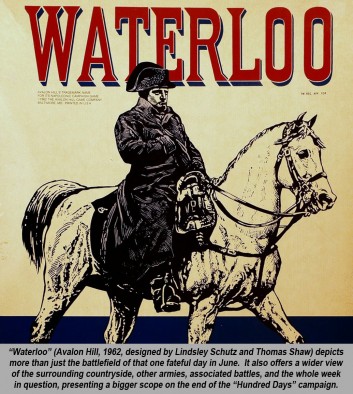
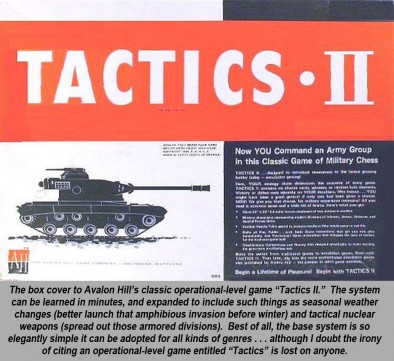
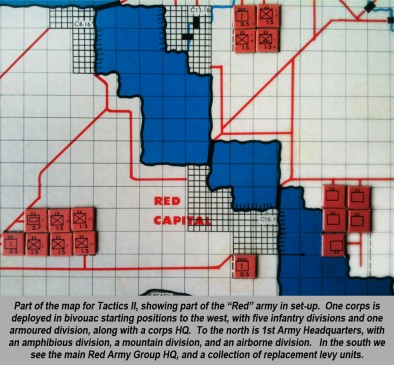
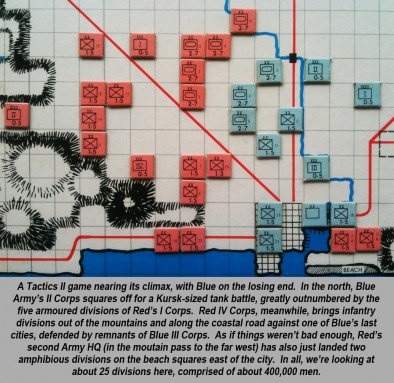
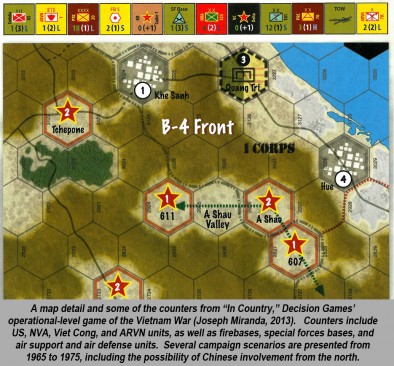
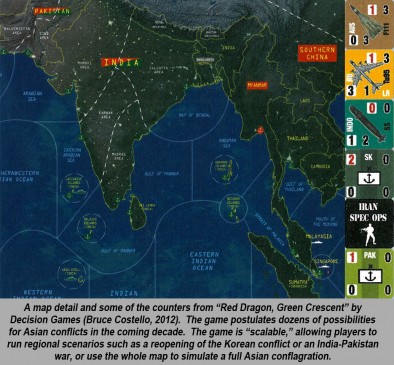
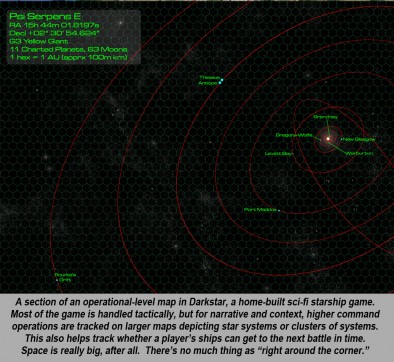
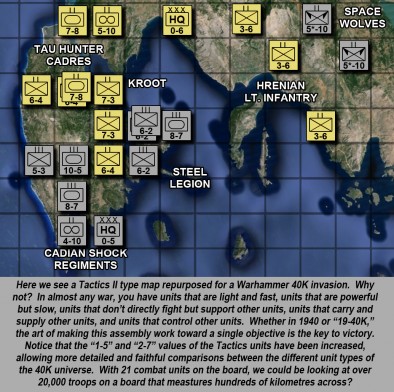


































Another intriguing article. I have played campaigns where maps and written plans were used to initiate the conflict, which was given greater granularity by zooming in on specific events. In the most free form version, engagements were quite realistic in that recon units from one side could stumble upon a massive outflanking manouevre by the other, or either side attempted crafty moves that led ultimately to them running headlong into one another. And it does mess with your brain, though I have to admit many of these were played before computers and spreadsheets and databases were something you could arrys… Read more »
Thanks, @dorthonion . I like the idea of written orders, so opposing players are made to commit to certain courses of action without knowing or seeing what the enemy is up to. Of course, hidden movement and “true” reconnaissance is always a little tough to handle in a board-mounted wargame. The way we’ve done it is through the use of inverted counters. Real units and “dummy” counters look the same on the back, and all counters are moved around inverted. Players who are crafty (as you say) can make careful use of these units to mount feints, non-existent attacks or… Read more »
Thanks for those great articles. Gives quite a new perspective.
Are the rules for e.g. Tactics II still available? Which newer (still in print) systems are recommenable for such operational wargaming to convert to (if it’s not by itself) sci-fi?
Best regards.
Thanks, @gridreaper . Sadly, Tactics II (and most other Avalon Hill games) have been out of print for quite a while. One possibility for a newer, sci-fi based command-tactical or operational-scale system was originally suggested by @torros … Strike Legion Planetary Operations by Legionnaire games. http://www.wargamevault.com/product/88997/Strike-Legion-Planetary-Operations-Blue-Book–Demo-Version?filters=0_0_40014_0 As far as Tactis II rules go, I want to be slightly careful here about passing out published material (I don’t want to get Beasts of War in any trouble) – but there are some resources online already. Here’s a YouTube video that talks about the basic rules. https://www.youtube.com/watch?v=xShEP0TI6HM Boardgame Geek has some of… Read more »
Good afternoon @gridreaper ~
Not sure if you can see it, but I sent a response about your question that is “awaiting moderation.” 🙂 I think I might have included too many links. Obviously, I didn’t give out the Tactics II rules (out of print but still copyrighted), just tried to point you in the right direction. 🙂
I dont think Tactics 2 has been published since the revised edition in the early 70’s . It was first published in the late 50’s as the first ever board wargaming
Sadly there aren’t many operational style SciFi games out there
Oh damn, @torros – I just mentioned you as a source for “Strike Legion” – which might not be strictly operational scale, but a step in the right direction. 🙂
There larger scale game Planetfall would be a better option though still a miniatures game and might not be what I might call operational, (i.e counters/miniatures not representing armies etc) Prefect from Renegade Legion is the only other one I can think of.
Where can I get info on the Tactics II Warhammer 40k Invasion shown above.
Thanks, @trideau . That invasion was put in as an example of what players could do using a simple, easy-to-learn system like Tactics II to run large-scale operations in other settings. It certainly hasn’t been built yet, but was offered as an example of what COULD be built if players were so inclined. I don’t want to actually give out the Tactics II rules (I don’t own them obviously) but Boardgamegeek,com has a lot of information on the game system. I could certainly build such as system in a BoW forum somewhere, but I’d have to learn a lot more… Read more »
Prefect was totally my first response . . . but I don’t think Prefect is in print anymore. either ( @gridreaper was asking about in-print games). I still have my old set of Prefect (and Tactics II) at home. 🙂
A great Computer Wargame that people can play to get a taste of this: http://unityofcommand.net/ Also: Hearts of Iron III (or wait till 4) is a great game to explore the nuances of Operational Level and beyond. For Command another game to try is Wargame: Red Dragon, it is competitive, the turn based system gives the game a Command Level game with Operational Elements. If you want to design a fast paced system for a game just for you to try our with minis, these would be good to look at. Affordable indie rulesets that also are great resources to… Read more »
Awesome, @leoleez. I saw Gruntz 15mm in wargamesvault.com, but for some reason assumed it was a tactical game (probably the “15mm” threw me off:) )
Thanks!
If you want to design your own it might be worth looking at this
http://delyall.tripod.com/berthier/berthier.html
Its a computer based campaign system, works quite well
Damn, @torros . That looks like a kicka** little tool there. You’ve actually tried this out? You say it works pretty well? I presume it works more for tracking larger-scale movements until units meet, when players would resolve the action their own way (perhaps in a tactical table top).
Its not the most complicated..but a friend ran it for a Crossfire campaign and it handled all the fog of war well enough, though my friend said it does take a while to set it all up
Sounds true. Multi-level games (play op-scale movement on one map, resolve each battle via smaller tactical games) are always massive, so matter how hard players and referees try to limit their scope at the outset. True Frankenstein monsters, they will always get out of control and turn on their creators, bwahaha!
Not trying to discourage anyone, just warning everyone … hold on tight!
ahh Tactics…sniff sniff my very first ever war game. Great article, I almost feel like I’m getting a military strategy and tactics lesson as I’m going through these articles. Thanks for all your hard work!!!
Thanks, @gladesrunner . Although of course I would never presume to teach (or know about) real battlefield tactics or operations. I am the definition of a true “couch potato” general. 😀
Very interesting editorial my experience at this level of gaming is limited very good quality all the same.
40k invasion may not be in production but Warhammer invasion is available if people are interested.
This is a good site for all gaming interests with links to clubs & dedicated sites
http://www.boardgamegeek.com/
Thanks for the feedback and information about Warhammer 40K, @zorg . I hope you saw where I gave you your props in the posts up above. 🙂 Again, totally guessing on the 40K invasion graphic. Hope I wasn’t too far off.
Thanks @oriskany i just gave you the ammo you’re the one that hit the targets just like (upham).
I have never played Dropzone Commander but looks as if it could be tweaked to be used for EPIC 40k don’t even know anyone to find out if that is even realistic.
My only reservation about that (other than the fact that I haven’t gotten the opportunity to play DZC yet) is that DZC seems to be a 10mm tactical game, with each piece representing a vehicle and true line of sight rules. Thus, it’s the same basic scale as 40K and so wouldn’t offer any scale-up leverage? Not familiar with either game in detail so I could be totally off there. Besides … we keep hearing these rumors about a larger-scale DZC game coming out?
True true just throwing a suggestion into the air to see if anything may come from it?
Tell you what, though. Once players find / develop an operational-level game for 40K planetary invasions, it would probably be “convertible” to DZC?
The original rules were still available on the net it’s finding models to play with that going to be the problem I think?
Original rules for . . . I lost track. DZC? Epic 40K? Tactics II? 🙂
Another great article Oriskany. I’ve always been a little intimidated by operational scale gaming because the only thing I own (purely for the map and counters) is Advanced Third Reich; with its rules the size of a phone book.
Someday I would like to try a simpler operational game like Tactics II or the like. But as you said, even just playing around with maps and such can inspire your tactical games. Good Stuff!
Rise and Decline of the Third Reich is a pretty serious game. I guess I would call it strategic-level, but since it only depicts Europe, Russia, and North Africa (as opposed to the whole world) it probably borders on operational in some regards. Operational games run the full, and I do mean full, spectrum of intensity and complexity. I can honestly say the SOME of most complex wargames I’ve ever seen (games that make Third Reich look like tic-tac-toe) and the simplest wargames (not counting “board games” like Axis and Allies, Stratego, and Risk) can be classified as operational-scale.
40 K rules were available 6/7 months ago
This was the game with 6mm figures right (40K Epic), for really large 40K tactical games? I really don’t know much about 40K.
Once you get into operational-level games, you’ve really left miniatures behind . . . unless you use them strictly as force markers, or you play on really big tables! 🙂
Yes I play the table game several time’s still have the PC version Final Liberation somewhere in a box gathering dust one of the few games I finished.
Operational-level games handled on the PC are usually really good, especially if you stick to turn-based ones (call me old fashioned, but I’ve never really been a fan of RTS . . . although some more recent releases have pleasantly surprised me). PC platforms allow great handling of some of the trickiest parts of operational-level gaming, like concealed movement and resource management. Just going by what I read on Wikipedia, Epic 40K seems to fall generally into a “command tactical” category. I wonder if anyone really came up with an operational-level system (even if only for their own “dining room… Read more »
The Idea of written orders is always fun. Lost count of the number of times I’ve called in artillery on unfortunate places…
Gotta admit I called in artillery on myself once in GDW’s “Assault” World War III game. Poor Russians. 🙁 I was also running some beach landing games (Normandy and Sea Lion) in Panzer Leader and when a stack of infantry platoons gets jammed up on those beach hexes, bad things happen. The assault platoons get pinned down, desperately call in “danger-close” fire missions on German units right in adjacent hexes . . . then the Allied units get dispersed so the artillery mission drifts . . . then you get an unlucky roll on your scatter table . . .… Read more »
If you guys like this level and style of games then check out our new project; Sector Commander: WWII. Its based at Company level but forces will be sold in Divisional boxes so collecting large scale Armies will be simple! Combine map sets and you could have a huge game with multi Divisional combat… will really give your brain a work out! We love the tactics and strategy offered by these style of games as a nice counterpoint to the visual among of 28mm for example. Offers totally new challenges as its not just about winning the firefight between two… Read more »
I checked out the link and Sector Commander definitely looks great so far. I particularly liked the unit marker for a company of the British 6th Airborne Division. Major Howard lives on!
This series makes me ever more curious to try some of these higher level games. I am missing some clear references, especially for the computer games, to be able to quickly find more information about these games or where to get them. The Tactics maps reminded me of the Advance Wars series for Game Boy Advance and DS, Those games bridge a gap between tactical games and some operational elements. You can produce units beyond your starting force. And you can transport and heal units to keep them in the fight longer. But the game is presented as a series… Read more »
Thanks, @bucketknight . The first computer games that come to mind applying to operational-level gaming is Matrix Games’ “Operational Art of War” series. Also by Matrix Games, I have also played Gary Grigsby’s War in the East: The German-Soviet War 1941-1945, which has fantastic detail (even in a computer, a full game may take days to play). There’s also Matrix Games’ Operation Barbarossa – The Struggle for Russia. The Operational Art of War series probably has the widest appeal, since it doesn’t focus strictly on the Eastern Front. It also covers wars up to the modern day. It’s turn-based (thank… Read more »
A plan of downright Baldrick-ian cunningness has occurred to me; might it be possible to hybridise operational and tactical scale games in fashion where, rather than every or even most engagements being resolved at the tactical level, the bulk of the conflict occurs at the operational level? You could develop a system where the players can every operational turn – or perhaps every ‘X’ number of turns, tuned for a balance of strategy and playability – nominate a particular engagement as of great significance among those initiated on the operational level that turn to be resolved on the tactical level.… Read more »
Yes sir. I have thoughts. Many. Where to begin? One: I haven’t written the multi-level game article yet. So stop stealing all my material! 🙂 Totally kidding, of course. These are really great ideas on circumventing the great pitfall of multi-level games, the amount of work and tactical game resolution involved in such an operational level campaign. I’ve run my share of these beasts and not only can the scale of the enterprise be daunting, but scheduling can turn into a mess, too. If one “required” player can’t show up to play his tactical game, the whole campaign can be… Read more »
I would be delighted if any of my inane wittering might actually be of some kind of use for once. Feel free to adopt whatever bits and peices might be of interest. I am not fussed about the apportioning of any credit just so long as the ideas might actually inspire people or help them when they decide to wrestle te many tentacled beast of higher streategic campaign wargaming (and so long as I don’t get the blame if it all comes crashing down around their ears). As for the parallels in the way we approach the topic; what can… Read more »
“… it seems that slightly unhinged wargamer types think alike…” True enough. We all share that same “gene,” after all. No matter what genre we’re talking about (personally I have tried WW2 historical, sci-fi, and medieval), operational-tactical crossovers or multi-level games always run into the same basic, monolithic issue. I’ve heard of, seen, and/or tried two or three different solutions and approaches to this problem. Yours (about both sides “choosing” one battle per operational turn to resolve tactically) would honestly be a “fourth” idea I’ve never seen. More ideas is always a good thing in discussions like this. 🙂
You could also develop the idea further, with each player writing they preference down separately without telling each other, and then revealing their picks to one another simultaneously, further compounding a sense of the ‘fog of war’ where you have to try to anticipate your adversary’s moves from what you know of their force disposition (subject to available intel) and prior strategy rather than having any concrete advanced knowledge. That said, if your intelligence network is good enough, maybe you could intercept sealed orders or decrypt secure military transmissions, which might allow you to change your pick after all choices… Read more »
These are definitely good variations on the idea. The two sides could roll something like “operational initiative” (which they’d probably have to do anyway when moving groups of units earlier in the operational turn). The nice thing about initiative rolls is they can be modified, reflecting all kinds of conditions like you mention. Players could also have access to something like “operational priority points” to be spent each turn. Say one of these OP points can either (a) bring on 100 points of tactical-game reinforcements, (b) supply / feed 1000 points worth of tactical-game reinforcements, of give you a +1… Read more »
I particularly like the idea you suggest of playing your opponent’s expectations and perceptions – the sheer sneakiness of it all appeals to me no end. 😉
Tactics within tactics . . . plans within plans . . . Bwahaha!
Like they say in poker: Don’t play the game. Play the man.
This song immediately comes to mind; http://www.youtube.com/watch?v=WEhS9Y9HYjU
Sorry, I can’t help myself
This song Immediately cpomes to mind.
http://www.youtube.com/watch?v=WEhS9Y9HYjU
Sorry, i can’t help myself… 🙂
Cool song, but kind of benign for the nefarious trickery we’re talking about. 🙂
But of course – the greatest deceptions always maintain a benign façade, at least until it is too late to avert catastrophe… 😉
“. . . that’s such a nice song. So pretty . . . hey, what’s he doing with that knife? And why is he smiling?”
School of hard knocks: “Sneak peaks! Low blows!”
Like Sun Tzu says: All warfare is based on deception.
“Just wait until the treachery phase! Mwa-ha-ha-ha-ha!”
If his legend is believing deception was basis for his success.
Hello, @mecha82 . Just so I can be sure I understand your post, did you mean to say something like “If his legend is to be believed, deception was the basis for his success,” something like that? Is this a reference to the theory that Sun Tzu may not have have existed as a single writer or commander, but a series of writers from the same general period? I’ve read and heard that theory proposed, I don’t know how much support it has. The general idea is similar to the idea that’s been proposed about Homer, whether he was single… Read more »
More like reference to story were he was leading smaller kingdom’s army against bigger kingdom and using deceit to win war. There is no way to tell is it true or not so that’s why I used word legend because likely that’s what it is.
True. Once we get that far back in history, separating the myth from the fact becomes problematic at best.